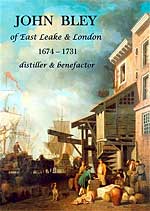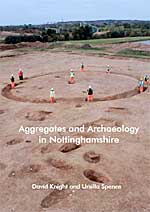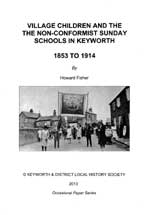Book reviews, Summer 2013
JOHN BLEY OF EAST LEAKE & LONDON 1674-1731 DISTILLER AND BENEFACTOR.
Keith Hodgkinson, Rachel Flynn and Ian Flynn; East Leake and District Historical Society, 2012. ISBN 978 0 9531710 3 3

If you have ever wondered about the origins of the very clearly dated building on Main Street in East Leake as you head towards Loughborough on the No 1 bus, then this is the book for you. The house was built by the London distiller John Bley with money made from his London business and with the possible help of Sir Thomas Parkyns of Bunny. As to the dates, 1715 and 1728, well the answer is still elusive for whilst 1715 marks the building of the house the latter date remains a mystery.
John Bley was born in East Leake in 1675, the illegitimate son of Elizabeth Wight who steadfastly refused to name the father, but as she was part of one of the village’s elite families she was never forced to render the father’s name to the churchwardens. Suspicion has fallen ever since on William Bleay (or Bley) the young curate in the village who moved shortly afterwards to Worcestershire with several references but not a word from his own rector. Probably accommodated in the home of her married sister Mary Hopkins, Elizabeth ensured that John received an education: he and his cousin went to the private school in Hoton. The 15-year old John Bley was then apprenticed to a distiller in London, perhaps using the extensive Wight family contacts in the city. Seven years later he was a distiller himself, freeman of the City of London and member of the Worshipful Company of Distillers. By 1703 he had a shop on Thames Street, where he lived for twenty years. John Bley continued to maintain the connection with East Leake and made friends with Sir Thomas Parkyns as well as ensuring the well-being of his mother who remained unmarried for the whole of her life. Bley not only built the house on Main Street, he ensured that a school was started up in the village just after his house was completed.
This book skilfully places John Bley into the two contexts of rural Nottinghamshire and metropolitan London and demonstrates that it was possible with the right combination of circumstances for an illegitimate child to become a successful businessman and friend to titled gentry. Social position and money play an important part of this for Elizabeth Wight was part of the broad village elite and could be accommodated by her sister who continued the family’s claim to be part of the yeomanry strata through her marriage to a yeoman. Furthermore, family connections in London had ensured John a foothold from which to make start there. Interestingly John too played the social status card for when he claimed, when being apprenticed, that he was the son of William Bley, clerk (cleric) at that point thus ensuring himself a suitable good background. His association with Parkyns was a combination of money- John had possibly acted as an agent for Sir Thomas – during financial difficulties and outward social deference for Sir Thomas was an important figure in Nottinghamshire governance; but despite this Bley had to make a success of his business and this required skill and knowledge. The book demonstrates clearly how Bley developed his business in London through dint of talent and hard work and how that enabled him to, in turn, develop his home village. All this building and educational concern was despite his clear intention to reside in London until later in his life. This book is more than a biography of a remarkable man, it is an excellent introduction to the social and political worlds of London, especially in relation to the gin and broader drinks trade in the capital and the three authors have successfully combined local and regional history with the history of a significant part of London life. There is significant genealogical work in the book too in order to show how the Wight and Bley families worked together and continued to coalesce as Bley’s own career developed. This is a book with manifold uses. It is excellent contextualised local history, demonstrating how city and county were not completely separate worlds, moreover it is a great biography of a significant local man and it is a fascinating insight into the cultural and material worlds of the seventeenth and eighteenth century merchant.
Professor Martyn Bennett, Trent University
AGGREGATES AND ARCHAEOLOGY IN NOTTINGHAMSHIRE
David Knight and Ursilla Spence; York Archaeological Trust, 2013; ISBN 978-1 874454 63 2

This is an A4 booklet of 54 pages produced with a gloss cover and high quality paper inside pages with good colour illustrations, maps and diagrams, which was launched at BGS, Keyworth on 15 May at the fourth GeoArchaeology Conference.
The research for the book was done between 2009 and 2012 with funding from the Aggregates Levy Sustainability Fund. The full report can be downloaded from the websites of the Nottinghamshire County Council (www.nottinghamshire.gov.uk/learning/history/archaeology, Trent & Peak Archaeology (www.tparchaeology.co.uk/notts-aggegates-resource-assessment) and the Archaeology Data Service (http://dx.doi.org/10.5284/1018086). There is a GIS (Geographical Information System) which may be consulted through the Nottinghamshire Historic Environment Team.
The project covered forms part of a package of Aggregates Resource Assessments which provide a resource for assessing the archaeological potential of the aggregates-producing areas of England. Similar assessments have already been completed for Derbyshire and the Peak District, Leicestershire, Lincolnshire, Warwickshire and Worcestershire and others are currently in production for Herefordshire, Northamptonshire, Shropshire and Staffordshire.
The authors have liaised with colleagues working in neighbouring areas of the Midlands to achieve compatible products and so have used the landform element methodology pioneered in the Till-Tweed catchment and extended in the Derbyshire and Peak District work.
The book outlines the national framework before moving to the Nottinghamshire context in several areas and then considers in detail the historical periods in the county from the Palaeolithic to the Post-Medieval and Modern. The final sections deal with Landforms and Archaeology, looking at assessment, evaluation and mitigation strategies together with an Archaeological Research agenda and strategy compilation. This is a very high quality and meticulously prepared volume which will be of tremendous help when aggregate extractions are proposed and especially when linked with the related reports from other aggregate and mineral producing areas of England. It is well-written, easy to read and follow and recommended to anyone interested in the archaeology of the county or the aggregate extraction industry.
VILLAGE CHILDREN AND THE NON-CONFORMIST SUNDAY SCHOOLS IN KEYWORTH 1853 TO 1914. Howard Fisher; Keyworth & District Local History Society, 2013. £4.00

This 75 page booklet is the latest in the Occasional Paper series published by Keyworth & District Local History Society. It is A5 format and contains several illustrations, tables and charts in telling the story of how the children of this rural village received rudimentary education in the three ‘Rs’ through the Primitive Methodist and Congregational Sunday Schools of the village.
The booklet also looks at the way the children had to work from quite early ages and the occupations they followed in what was an open village where the main trades were centred around agriculture and the framework industry of knitting and shoe making.
The way the Sunday Schools raised funds, mainly through annual anniversary events, is explained and the associated expenditures – for example for Easter events around 4 stones of plum cake, three stones of bread, seven pounds of butter, ten pounds of sugar and one pound each of green tea, black tea and coffee were purchased!
Attendances are shown to have been very regular and it is concluded that most village children during the period studied would attend one or other of the two village Sunday Schools – there is no record of such a School at the Anglican Church.
The booklet is perfect bound and printed on high quality paper and well worth the cost to anyone interested in the subject or who might be contemplating a similar study in another village. The more these small scale studies are undertaken they help to build a larger picture of the influence that Sunday Schools had on the education of children whose parents could not afford to pay for education (the vast majority) within our county. Such publications are within the scope of many of our local history societies and the publications of the Keyworth Society and others such as that at Norwell are adding to understanding of village life of past times.
This booklet will be available from the Thoroton book stall at future lectures.